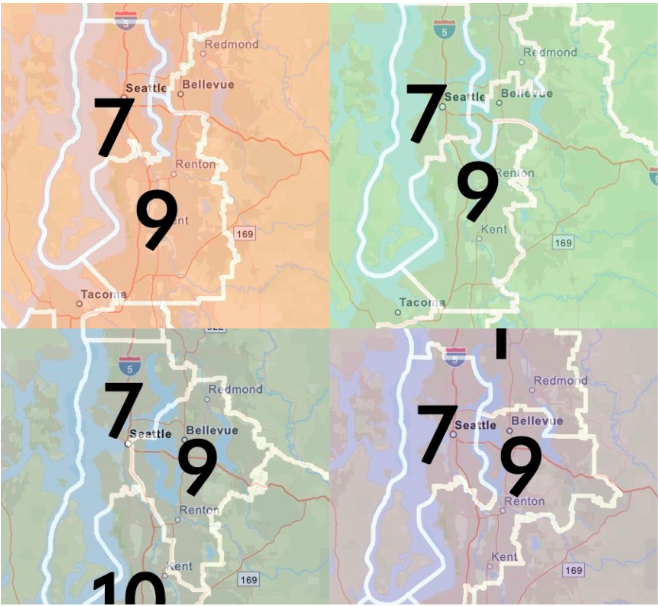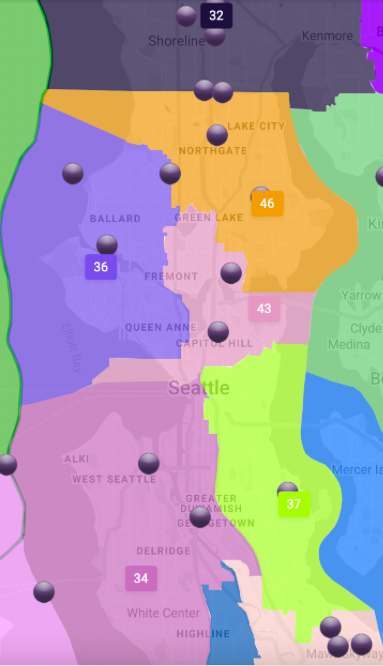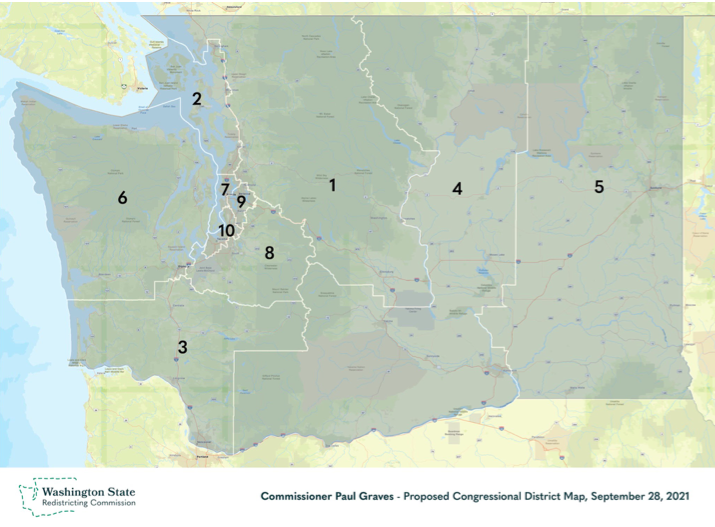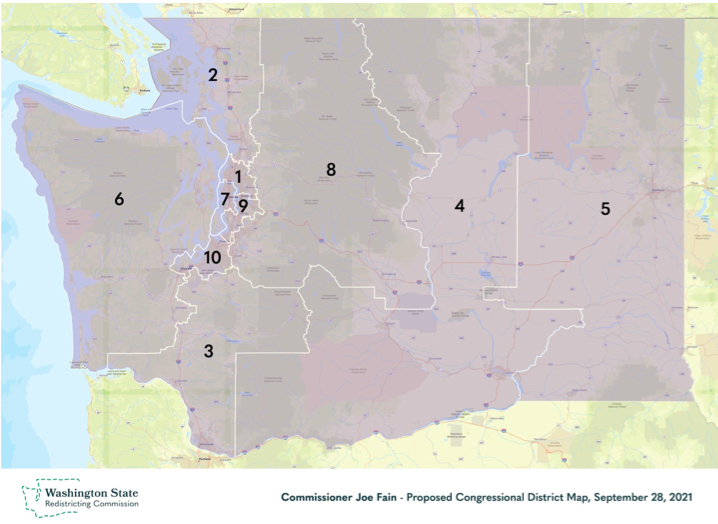Washington State’s redistricting process is off to the most contentious start in 40 years as Republicans propose aggressive gerrymanders of Seattle and the state as a whole.
A major battle is unfolding over redistricting in Washington State, one that could wind up in the courts for the first time in 40 years. With a deadline of November 15 to draw new maps, the coming weeks may be decisive for the future of Seattle and the state as a whole.
Republican commissioners, fueled by the same no-holds-barred radicalism witnessed by their fellow party members in other states and in Congress, have proposed extreme gerrymanders of the legislative and Congressional districts. Their maps are designed to favor their party at the expense of racial justice and voter choice, as well as to undermine Seattle and our ability to have our urban needs met.
Because Republicans have equal representation on the redistricting commission, they have leverage that could force Democrats to cut a bad deal in order to get maps approved – unless Democrats are willing to throw it to the Washington State Supreme Court.
How the process works
After court battles in the 1970s and 1980s, state legislators created a temporary bipartisan commission to draw legislative and Congressional maps. They then proposed a constitutional amendment (SJR 103) that voters approved in the 1983 election to make the process permanent. A minor revision in 2016 created the current language in the state constitution. Each legislative caucus — House and Senate Democrats, House and Senate Republicans — appoints a commissioner, leading to four members of the commission, along with a nonvoting chair chosen by the other four commissioners.
Both parties are guaranteed equal representation on the commission, even if one party has not actually earned it at the ballot box. At least three members of the commission must vote to approve a final map, which means that Republicans hold veto power over redistricting in our state. If no map can win three votes, the state supreme court will draw the maps. The legislature can make changes to the commission’s approved maps but only by a 2/3 vote.
Like the filibuster in the U.S. Senate, the rules governing the commission have the potential to cause enormous problems if one of the parties chooses to pursue an extremist political strategy that eschews cooperation, as the Republican Party has done across America. In recent years we have seen Republicans upend traditional norms and refuse to make reasonable deals, preferring to instead demand Democrats accept unreasonable demands in order for government to operate.
In 2011, Republicans demanded and won a favorable legislative district map in exchange for agreeing to draw Washington’s new 10th Congressional district favorably for Democrats. Republicans used that map to erode Democratic numbers between 2012 and 2016, before the state’s electorate grew bluer again.
This time around, the Democratic commissioners are April Sims, Secretary-Treasurer of the Washington State Labor Council and appointed by the House Democrats, and Brady Piñero Walkinshaw, a former state representative from the 43rd LD and appointed by the Senate Democrats.
The Republican commissioners are Paul Graves and Joe Fain, who both lost their seats in the state legislature in 2018 in King County districts that had been drawn in 2011 to favor Republicans. Fain was accused of rape in 2018, and has refused to resign from the commission even after an outpouring of community demands that he not serve.
Proposed Democratic legislative district maps
The Urbanist’s Doug Trumm provided a good overview of the legislative maps proposed by the two Democratic commissioners. Redistricting Justice for Washington and the Washington Community Alliance have also shared their analysis, including their priorities for the Yakima Valley and Snohomish County Legislative Districts (LDs). This article will focus on the impact to Seattle, and look more broadly at how the overall process may unfold.
The Democratic commissioners’ legislative district maps would not have major changes to Seattle’s legislative districts. Both Sims’s map and Piñero Walkinshaw’s map would bring the 46th LD entirely into Seattle, and would substantially bring the 37th into Seattle. The 36th LD has to shrink, and both propose moving Belltown into the 43rd to help achieve that.
Exhibit 1: April Sims’ proposed map of Seattle legislative districts
Sims’ map gives almost all of the 36th’s current territory north of 85th street (except for portions of Greenwood) to the 46th, whereas Walkinshaw’s does not. Walkinshaw includes more of Burien in the 34th LD by moving Vashon Island to the 26th LD, whereas Sims does not.
Exhibit 2: Brady Piñero Walkinshaw’s proposed map of Seattle legislative districts
Proposed Republican legislative district maps
The Republican commissioners’ maps, however, represent a clearly anti-urban effort to impose a radical gerrymander onto Seattle. Both Graves’ map and Fain’s map draw Bainbridge Island into Seattle LDs. While this wouldn’t likely change the partisan outcome of such a district, it would undermine communities of interest. Bainbridge’s concerns match the rest of Kitsap County — ferry dependent, less dense — and have little in common with the needs of the largest city in Cascadia.
Graves’ map would dilute representation by placing neighborhoods with high proportions of people of color in the Northgate-Lake City area into a district mostly anchored in Kirkland, and cuts the Delridge corridor in half.
Both Graves and Fain would cut Chinatown/International District in half along Interstate 5, significantly harming that community’s ability to represent itself in Olympia.
Fain’s map represents an even more aggressive gerrymander of Seattle, as if he has it out for the 36th LD in particular. He would chop up the 36th and put it into four different LDs, cutting Ballard in half and putting its dense core in the same LD as Magnolia, Queen Anne, and Bainbridge Island.
Notoriously, Fain has drawn a map for his old 47th LD in Kent that goes to great lengths to exclude people of color. Commissioners cannot run for election for two years after these maps are adopted, but Fain could run for a seat in his old LD beginning in 2024.
Congressional District Maps
This week the commission published their Congressional maps, and similarly, Graves and Fain proposed extreme gerrymanders designed to reverse the voters’ decision to choose Democrats to represent a majority of the state’s seats in the U.S. House.
According to Five Thirty Eight, the maps drawn by Sims and Walkinshaw would preserve the current split of Congressional districts – 7 Democrats, 3 Republicans. But the Republican commissioners seek to gerrymander their party’s way into two or three more seats.
Graves’ map would produce a 5-5 partisan split. His version of the 1st CD would go from Blaine to Ellensburg, leaving out the bluest parts of the I-5 corridor to draw a district that Five Thirty Eight rates as R+1.
Graves also radically gerrymanders the South Sound to create a Republican-friendly 8th CD that would run from approximately Lacey to Issaquah, again leaving out the blue parts of the I-5 corridor.
Fain’s map is less extreme in its changes to existing districts, but still achieves a similar result as Graves: only 5 Democratic seats, 3 Republican ones, and two swing seats.
Fain redraws the 6th CD to include more of Trump-friendly Southwest Washington, and redraws Kim Schrier’s 8th CD into what Five Thirty Eight rates as an R+4 district.
Both Graves and Fain shore up the 3rd CD for Republicans, turning it from an R+3 district into an R+11 safe red seat.
In Seattle, all four maps generally shrink the 7th CD, represented by Pramila Jayapal, into Seattle itself, along with Vashon Island. Graves’ map also adds the Kenmore and Juanita areas to the 7th CD, while Fain’s and Walkinshaw’s add portions of Shoreline.

Redistricting Justice for Washington and other groups have asked for Southeast Seattle to be included in a majority-minority 9th CD, but without Bellevue or Mercer Island, and concluded Walkinshaw’s map comes the closest to achieving this goal. Graves’ proposed 9th CD is largely White district centered on Bellevue and would not achieve the goals of a majority-minority district, diluting the votes of people of color.
Graves’ map seems unlikely to become reality given the major boundary shifts it envisions. But Fain’s map seems more of a likely bargaining chip, as federal Republicans eagerly want to reclaim the 8th CD from Schrier. One should expect Graves and Fain to push extremely hard for, at minimum, gerrymandering the 8th to undo Schrier’s wins in 2018 and 2020. Of course, the 8th CD was originally drawn to make Dave Reichert’s seat safer, after his two near-losses to Darcy Burner in 2006 and 2008. Notice how Republicans are again trying to use the redistricting process to undo rejection by the electorate.
Commissioners went to great lengths to draw legislative and Congressional maps that protect their favored incumbents. Independent redistricting commissions in California and Arizona, however, are not allowed to consider incumbent residency when drawing their maps.
Competition
Graves has been busy selling his maps as promoting “electoral competitiveness.” However, what he is really after is a Republican-friendly gerrymander. Graves’ map would turn five legislative districts that are currently blue into swing districts, despite the fact that voters there have clearly expressed their preference to be represented by Democrats and not by Republicans.
His proposal relies on a bad faith interpretation of the state constitutional rules governing the commission. The requirement to “encourage electoral competition” is intended to prevent legislators from drawing everyone in the state into ultra-safe seats. But it is not intended to promote gerrymanders that undermine voter choice.
In fact, the original arguments for the commission from 1983 undermines Graves’ case. The voter pamphlet statement for the constitutional amendment creating the commission, signed by Democratic and Republican legislators, cited the temporary commission as having produced “a plan which is fair, recognizes traditional communities of interest, and is constitutional. Passage of SSJR 103 will ensure that future redistricting efforts will be carried out in the same fair and independent fashion, and that the Legislature will not grind to a halt as members pursue their concern about districts suited to their ambitions.”
It’s hard to interpret this as supporting Graves’ effort to gerrymander the state in 2021 to give Republicans a chance to make up for decades of losses at the ballot box. Their arguments prioritize constitutionality and communities of interest, and make no mention of helping one party overcome years of losses at the ballot box.
Further, Graves’ claim relies on a narrow definition of “electoral competitiveness.” While there are only two political parties represented in Olympia, the Democratic Party here and nationally has become a de facto coalition of two proto-parties, one representing the progressive left and another representing the corporate right.
In 2020 many “blue” districts saw intense competition between these two wings of the Democratic Party. Former Speaker Frank Chopp saw a strong challenge from the left from Sherae Lascelles. State Senator Mark Mullet defeated a challenger from the left from Ingrid Anderson by just 58 votes — in the 5th LD, which Graves had represented until losing his seat in the 2018 election.
The Republican proposals clearly fly in the face of the will of the voters. In the 2020 presidential election Joe Biden won 75% of the vote in King County, 58% in Snohomish County, and 53% in Pierce County. This suggests it is impossible to draw lines that create additional “swing seats” in the Puget Sound core without gerrymandering on a massive scale. So that’s precisely what the GOP commissioners proposed in their draft maps.
Graves’ arguments also run into the reality that Republicans already got an unusually favorable legislative district map in 2011, and by the end of the decade were unable to compete successfully.
In fact, Republicans have a long record of failure to compete electorally going back four decades. They have failed to win a majority in the state House since the late 1990s, unable to consistently compete using maps drawn in three different cycles (1991, 2001, and 2011). Their situation in the State Senate hasn’t been much better. Republicans briefly held a State Senate majority in the early 2000s. Even their Senate “majority” during the mid-2010s was enabled by turncoat Democrats. Of course, the last time a Republican was elected governor was in 1980.
Washington Republicans haven’t lost elections because of the way the lines are drawn. They lose because voters have rejected them and their policies. Redistricting is not the place for Republicans to address that problem. Graves’ arguments about competitiveness are like the Buffalo Bills demanding wider goalposts after losing the 1991 Super Bowl, getting them, losing wide right again, and again demanding wider goalposts.
Graves is asking the commission to gerrymander the legislature yet again in his party’s favor despite the fact that they continue losing in existing swing districts. His proposals and his underlying logic are completely inappropriate and should be rejected out of hand. Unfortunately, that’s not so easily done given the bipartisan nature of the commission.
What’s next?
Washingtonians are used to Republicans proposing extremist ideas that promptly go nowhere in a blue state whose governor and legislature are reliably Democratic. However, we cannot simply wish away these extremist redistricting proposals, because of the unfortunate way our redistricting commission is structured. There is a very real risk that some significant elements of the GOP proposals will become reality unless there is intense pressure on the commissioners and the legislative caucuses to reject them.
How might this play out in 2021? It’s possible that Graves and Fain may insist on carving up Seattle in exchange for keeping the Yakama Nation whole in the legislature and for maintaining the status quo in the Congressional delegation. Or they may insist on drawing Kim Schrier out of her seat in Congress in exchange for abandoning their extremist demands for legislative district maps.

Robert Cruickshank
Robert Cruickshank is a transit rider and progressive campaigner who lives in Seattle’s Greenwood neighborhood. From 2011 to 2013 he served as Senior Communications Advisor to Seattle Mayor Mike McGinn.







